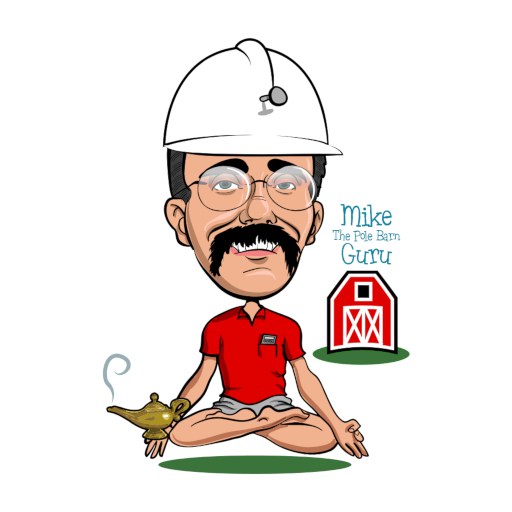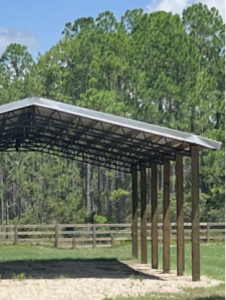Typically post frame (pole) buildings have a pressure treated board at the base of all enclosed walls.
 Known also as a Bottom Girt, Grade Girt, Skirt Board or Splash Plank, it is a decay and corrosion resistant girt which is in soil contact or located near the soil surface. It remains visible from the building exterior upon building completion, and is normally two inches in nominal thickness.
Known also as a Bottom Girt, Grade Girt, Skirt Board or Splash Plank, it is a decay and corrosion resistant girt which is in soil contact or located near the soil surface. It remains visible from the building exterior upon building completion, and is normally two inches in nominal thickness.
A decade ago, after CCA (Chromated Copper Arsenate) pressure treating went by the wayside, many splash planks were treated with ACQ (Alkaline Copper Quaternary). When water was introduced into connections between ACQ pressure treated lumber and steel, a chemical reaction occurred, which could quickly corrode steel siding and fasteners. For the most part, ACQ treated lumber is now rarely used, having been replaced by chemicals which do not interact corrosively with steel.
In efficient post frame construction, building components are positioned and connected in such a way to form a diaphragm. The gradeboard is an integral component of a properly designed shear wall (diaphragm) assembly. Structural wall sheathing (most commonly plywood, oriented strand board or corrugated steel) is attached to the gradeboard by sheathing-to-framing connectors which are located at the bottom edge of the structural sheathing panels.
The sheathing-to-framing connectors must be adequate in size, strength and resistance to pull out to be able to transfer shear loads, which are induced into the building by wind or seismic events, from the sheathing into the gradeboard. Similarly, the gradeboard must be attached to the columns at each end sufficiently to transfer the load.
At one time I had read a posting online, which downplayed the structural significance of gradeboards. In my mind, they are a key and important structural member.
Touted as an alternative to the traditional pressure treated lumber skirt board, is the composite grade board. Manufactured in a fashion similar to composite decking, they eliminate any risk of corrosion, rotting or decay.
The composite grade board features a built-in bottom ledge, which eliminates the need for a steel bottom trim (also known as base trim or “rat guard”).
Composite grade boards expand and contract dramatically with temperature fluctuations. As such, potentially unsightly gaps must be left at each end. For a 60 degree temperature fluctuation, a 3/16” gap is required (based upon a 16’ piece).
One of the “benefits” of the composite grade board is supposed to be price. I recently did a price comparison and found 2×8 #2 and better pressure treated at 97 cents per foot, while the composite grade board from the very same retailer was $2.99 per foot (over three times the cost)!
Having used composite materials for decks and stairs, I’ve found composites to not nearly have the strength of the lumber they are replacing. Furthermore, composites seem to allow a great deal of “give” around fasteners. When loaded in a shearwall assembly, I would have great concerns about fasteners pulling through composite grade boards.
The IBC (International Building Code) gives specifics in tables for shearwall construction, none of which include an approval for use of composite materials rather than dimensional lumber framing. Alternative materials are allowed to be utilized outside of the prescriptive portions of the Code, however testing documentation to prove structural adequacy should be provided.
Me…without some actual proven test results, there is no way on earth I would structurally use, or recommend the use of, a composite grade board.








Then what is a good way to do the bottom girt, I understand the importance of having your buildings perimeter sprayed and treated against termites. So what is good practice for this in wet cold locations where there are termites? What about using a composite board under your 2×6 or 2×8 pressure treated girt and adding a rat guard or plate that connects to the concrete and hangs over the composite board.
Good practice is to utilize a properly pressure preservative treated 2×8 or larger as the grade board.
Working from your suggestion, since the composite material would not be structural, any material which would not be fodder for the termites would work. A solution might be to add a layer of non-cellulose insulation board to the inside of the pressure treated grade board to isolate it from the balance of the building.
Cold is usually a good deterrent to termite invasion, however termites have been found inhabiting warm buildings in cold climates. In any case, it is prudent to make sure water does not stand against the base of the grade board, a good building site will be sloped away from the building so as to prevent ponding.
The pole building I am planning is on a lot with a slight slope and the soil is mostly clay, was going to do stone filled trench around 3 sides and run them down hill away from cleared area of building. Was planning crushed stone all the way around building sloping it away then river rock or something for landscaping so there shouldn’t be any water and was planning some sort of French drain. Should this pretty much eliminate a termite problem?
What about wrapping the exterior of the skirt board with aluminum flashing?
Possible, however you do run the risk of electrolysis should bare aluminum and bare steel become in contact with each other. If yo uare concerned about potential decay of the grade board (aka splash plank) why not just use Plasti-Skirts? https://www.hansenpolebuildings.com/2017/08/plasti-skirt/